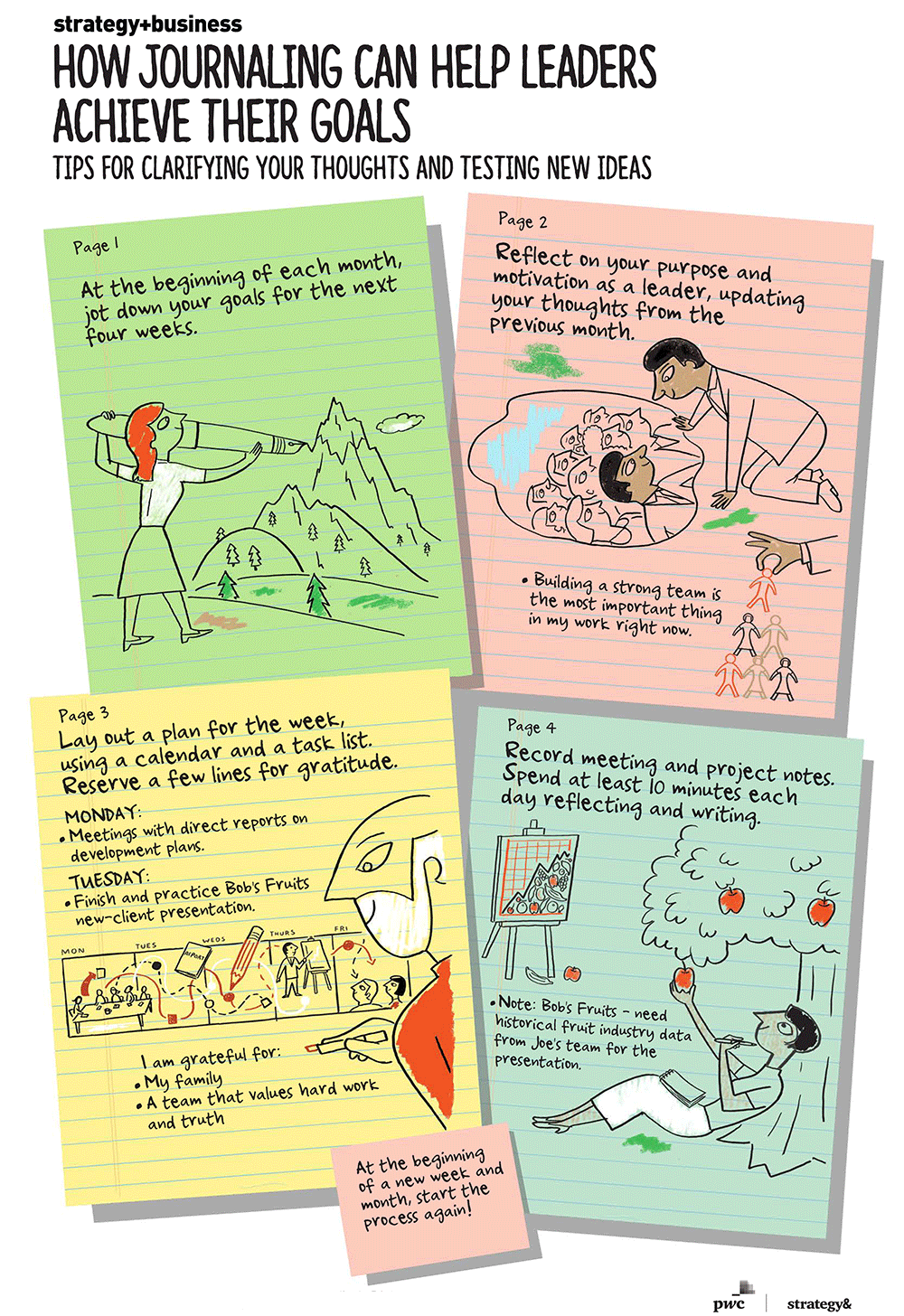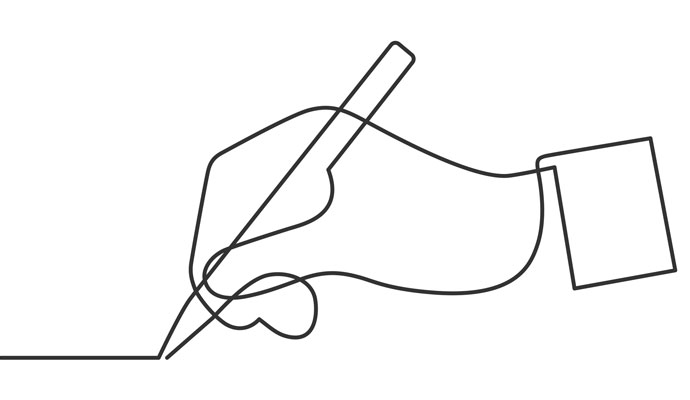Journaling Can Boost Your Leadership Skills
Stepping away from the screen and putting pen to paper allows the brain to reflect, process, and find patterns. See also “How Journaling Can Help Leaders Achieve Their Goals.”
Our lives are awash in digital. Each electronic pulse pushes us to respond instantly. Reply. Like. Share. There is seemingly no beginning and no end to the onslaught. But the beauty of the human brain isn’t its ability to render snap judgment and instantly weigh in on a topic electronically. Quite the opposite. Its greatest capacity is a higher level of thought: to process disparate bits of information, find patterns, and create meaningful dialog and action over time. All of this serves to boost our leadership skills.
This ability flows from our natural hardwiring. To benefit from it, you only need to slow down and let your inner genius emerge. To be sure, easing the pace of life is not so simple when bosses, subordinates, and family members assume you’ll be available online 24/7.
It’s time to slow down and reset expectations. But how?
A practice I have found useful, as have many of my executive education students and coaching clients, is centuries old: keeping a journal. Setting aside as little as 10 minutes a day to record your thoughts stimulates reflection critical to making sense of the fast-moving world around you, which is, in turn, essential to effective leadership. As a leader, you are challenged to perceive patterns from which opportunities and threats emerge. This, in part, makes you worthy of following. (As in actually following you in real life, not just your online persona.)
A practice I have found useful, as have many of my executive education students and coaching clients, is centuries old: keeping a journal.
Despite our current proclivity for keyboards and powerful computer processors, journaling is an activity best suited for pen on paper. In this case, analog beats digital because writing something down by hand triggers a part of the brain, known as the reticular activation system, to pay close attention, and may improve retention. Tapping keys doesn’t have the same effect.
Further, journaling engages the analytical, rational functions of the brain, which gives the more creative parts of your cranium space and time to work their magic. Neuroscientists have shown that this type of “mindful concentration” stimulates the parts of the brain that are active when not engaged in directed activity. This is why insights often pop up while you are in the shower, out for a run, or sitting with your journal.
In this way, journaling is an exercise that lets you articulate feelings, which can mitigate their stress-inducing effects; work through challenges; and test options. Also, moving away from your computer or smartphone relieves you of the distractions of email alerts and other digital noise. At its best, a journaling practice creates sacred space for developing a deeper understanding of yourself and the world around you, both at work and at home.
The trick is to see journaling as an opportunity, not a chore. It is, first and foremost, for you. Only when you are grounded in who you are — your values, purpose, aspirations, strengths, and fears — can you be the authentic leader worth following. Part of getting there is giving your brain time to process the onslaught of data with which it is barraged every day. Journaling helps you do just that, as it allows you to garner the benefits of both focus and “unfocus.”
There is an I/we dynamic that enables the benefits of journaling to scale. For example, a semi-structured journaling session could be based on three ritual questions: When did I feel strongest today? When did I feel weakest? What does this tell me about myself? Modified slightly, you could ask similar questions on alternate days: When was my team at its best today? When was it at its worst? What does this tell us about ourselves, our customers, or our market? Contemplating these questions and jotting down your thoughts, without worrying about spelling or grammar, helps you tap more of your cognitive capacity as you learn through writing. If that is too much structure, simply let your thoughts flow and be alert for emerging patterns. It is interesting to go back through your notes every quarter or so to see trends and remember both high and low points.
The first reaction to the suggestion of keeping a journal is often that there isn’t enough time. To that I reply: How much time did you spend writing emails today? Or posting on Facebook? There is time if you want there to be. It is a bit of self (not selfish) time with numerous benefits, including improved memory, enhanced cognition, and perhaps even better physical health.
LinkedIn CEO Jeff Weiner reports that he spends 90 to 120 minutes each day reflecting. I don’t know if he uses a journal. If not, I suggest he do so in order to capture his insights.
There is no perfect once-size-fits-all journal or one right way to journal, so I encourage you to experiment. After trying several methods and books, here is how I now use a standard, ruled journal:
• At the beginning of each month, I use one page to write down my overarching goals for the next four weeks.
• On the facing page, I take about 30 minutes to reflect on and write my personal manifesto, which articulates my purpose and motivations, updating it from previous versions as I feel necessary.
• On the next spread, I lay out my plan for the week. On the top half of the two pages, I create a calendar where I can note appointments, travel plans, and other time-specific events. On the bottom, I make a task list with modified Bullet Journal symbols. Carryover items from the previous week are followed by a number that indicates how many weeks each has been on the list. A number bigger than two prompts an examination of why I’m not getting something done — and whether it’s really worth doing.
• The last four lines of the right-hand page are reserved for gratitude. I try to capture three to four things for which I am grateful each week.
• Subsequent pages are used for meeting and project notes along with various thoughts and ideas. At least 10 minutes each day are reserved for reflection, and these pages are the ideal space.
• At the beginning of a new week and month, I start the process again using the next available spread.
This approach keeps everything in one place and fosters feedback loops that integrate “being” (who you are and what you value as a human being) and “doing” (your meetings, projects, daily activities, and making connections between your larger purpose and specific goals).
While digital is dizzying and often encourages us to speed up, analog is reassuringly grounding and provides space for reflection and contemplation. Annie McKee, author of How to Be Happy at Work, told me, “Overwork and stress are epidemic. That means we’re not at our best emotionally, physically, or mentally. The antidote is to focus on activities that help us slow down, calm down, and reflect. Doing that, and staying away from the to-do tasks, centers you on the future, hope, and relationships. It triggers changes in the brain that help us deal with the stress.”
Leaders are wise to note what a little quiet time alone with a notebook and pen can yield.





